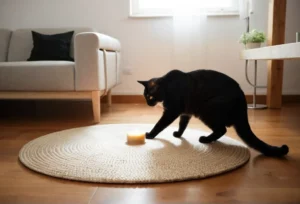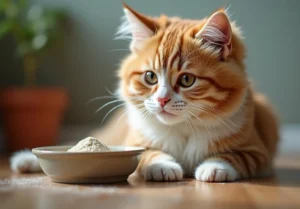Cats are fascinating creatures with a plethora of unique behaviors, one of which includes fluffing their tails when scared. Have you ever wondered why they do this? Let’s explore the reasons behind this intriguing feline behavior.
Cats fluff their tails when scared as a defensive mechanism to appear larger and more intimidating to potential threats. This instinctual behavior is deeply rooted in their evolutionary past and serves as a way for cats to protect themselves in the face of danger. Now, let’s delve into the specifics of why cats exhibit this behavior when they are feeling frightened.
Evolutionary Instincts
Cats fluff their tails when scared due to their evolutionary instincts. This behavior dates back to their wild ancestors, who would puff up their fur to appear larger and more intimidating to potential threats. When a cat is scared or feels threatened, their body goes into fight or flight mode, and fluffing their tail is a way to make themselves look bigger and more formidable. This instinctual response is hardwired into their DNA, helping them to survive in the wild by dissuading predators or other dangers.
Communication Signals
A cat’s tail serves as a crucial form of communication, and when they fluff it up when scared, they are sending a clear message of fear or discomfort. Cats have a complex body language system, and their tail is one of the key components. A fluffed-up tail not only makes them look bigger but also signals their emotional state to other animals or humans around them. It’s a warning sign that they are feeling threatened and may need space or reassurance.
Unique Insight: Cats also fluff their tails to protect their vulnerable body parts like their belly. By making themselves appear larger, they are instinctually guarding their most sensitive areas from potential harm.
Remember, if you notice your cat fluffing up their tail when scared, it’s essential to give them the space and comfort they need to feel safe again. By understanding their evolutionary instincts and communication signals, you can better support your feline companion in times of fear or stress.
Heightened Awareness
When cats are scared, they enter a state of heightened awareness, ready to assess any potential threats in their environment. Fluffing their tails plays a crucial role in this process as it serves as a visual cue to any predators or dangers lurking nearby. By making their tail appear larger, cats aim to intimidate potential threats and appear more formidable.
In addition to intimidating predators, the fluffed tail also helps cats gauge the space around them better. The expanded tail provides a better sense of their body’s size relative to their surroundings, aiding in spatial awareness. This increased awareness allows cats to assess potential escape routes and prepare for a fight or flight response.
Fight or Flight Response
When faced with a perceived threat, cats experience a fight or flight response similar to what humans go through. The fluffed tail acts as a physical representation of this response, signaling to other animals that the cat is ready to defend itself if necessary. This reaction is deeply ingrained in their instinctual behavior and helps them survive in the wild.
It’s important to understand that fluffing their tails is not a sign of aggression but rather a defensive mechanism. Cats are naturally inclined to protect themselves when they feel threatened, and the fluffed tail is just one way they communicate their discomfort or fear. By recognizing and respecting this behavior, we can better understand and support our feline companions in times of distress.
Additional Insight:
– Cats may also arch their backs and flatten their ears in conjunction with fluffing their tails when scared, creating a full-body defensive posture. This combination of physical cues further communicates their heightened state of alertness and readiness to defend themselves.
Body Language Analysis
When a cat fluffs its tail when scared, it’s actually a defense mechanism triggered by fear or stress. The fluffing of the tail makes the cat appear larger and more intimidating to potential threats, signaling to predators or perceived dangers that the cat is not to be messed with. This behavior is similar to a porcupine raising its quills when feeling threatened. Noticing this tail fluffing can help you understand your cat’s emotional state and provide the appropriate support and comfort when needed.
Social Interactions
Cats’ interactions with other felines and humans play a significant role in their behavior of fluffing their tails when scared. For example, a cat that has had negative experiences or lacks socialization may exhibit this behavior more frequently. Conversely, a well-socialized and confident cat may not fluff its tail as often when faced with scary situations. By fostering positive social interactions and providing a safe environment, you can help reduce your cat’s tendency to fluff its tail out of fear.
Additional Insight:
Tips on how to help your cat feel more confident and secure include providing plenty of hiding spots, vertical space for climbing and exploring, and engaging in interactive play sessions to build trust and bond with your feline companion. By creating a supportive and enriching environment, you can help minimize your cat’s stress and fear responses, reducing the need for tail fluffing as a defensive mechanism.
Behavioral Evolution
Domesticated cats have retained the instinct to fluff their tails when scared due to their evolutionary history as solitary hunters. In the wild, a puffed-up tail makes a cat appear larger and more intimidating to potential threats, helping to deter predators or enemies. Despite living in our cozy homes, our feline friends still exhibit this behavior as a survival instinct passed down through generations. So, the next time your cat’s tail fluffs up at the slightest scare, remember it’s just their ancient instincts kicking in!
Coping Mechanisms
When faced with a scary or stressful situation, cats often fluff their tails as a coping mechanism to regain a sense of control. By making themselves appear larger and more intimidating, they hope to ward off the perceived threat and feel safer. Tail fluffing can also help cats release pent-up tension and anxiety, allowing them to assert their presence in the face of fear. So, if your cat’s tail poofs up when startled, it’s their way of trying to manage their emotions and assert themselves in a scary situation.
Pro Tip: Providing your cat with a safe and quiet space to retreat to when they feel scared can help them feel more secure and reduce the need for tail fluffing as a coping mechanism.
Interesting Facts
Cats are fascinating creatures, and their tail behaviors never fail to intrigue us. Did you know that when a cat fluffs its tail when scared, it’s actually trying to make itself look bigger and more intimidating? Yep, just like puffing out your chest to look tougher! This behavior is known as piloerection, where the hairs on the tail stand on end to make the cat appear larger and more threatening to potential predators.
Here’s a fun fact: a cat’s tail is an excellent indicator of its mood! When a cat is scared, anxious, or feeling threatened, its tail fluffs up as a defense mechanism. So, if you see your furry friend with a puffy tail, it might be a good idea to give them some space to calm down and feel safe again.
Another interesting tidbit is that a cat’s tail is also used for balance and communication. Aside from fluffing up when scared, cats use their tails to signal their emotions to other felines and even to humans. So, the next time you see your cat’s tail fluffed up, remember that it’s not just a random behavior – it’s their way of expressing how they feel in that moment.
And speaking of tails, did you know that a cat’s tail is comprised of up to 20 vertebrae, making it a remarkably flexible and expressive appendage? It allows them to communicate a wide range of emotions and intentions through the subtle movements and positions of their tail. So, the next time your cat fluffs up its tail when scared, remember that it’s not just a fluffy display – it’s a complex form of communication and self-defense rolled into one!
Remember, your cat’s tail is like a furry mood ring, giving you valuable insights into their feelings and intentions. So, the next time you see that fluffy tail, give your feline friend some space and understanding, and watch as they navigate their world with grace and poise, tail included!
Alex, a passionate animal lover, has experience in training and understanding animal behavior. As a proud pet parent to two dogs and three cats, he founded AnimalReport.net to share insights from animal experts and expand his knowledge of the animal kingdom.




